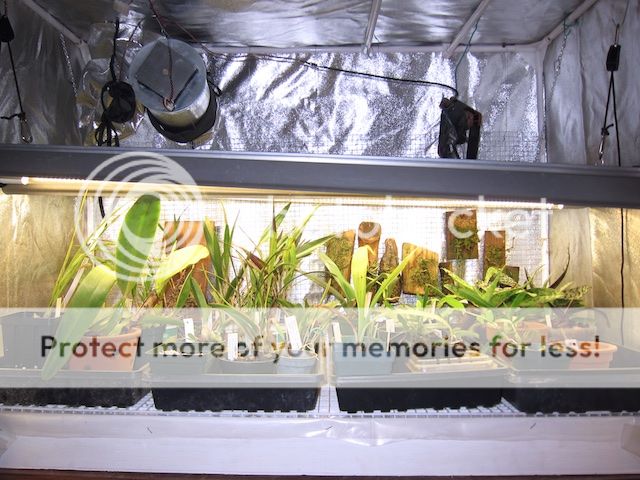
In Fairbanks, we get -40F (=-40C) in the winter every year, so it is not economical to grow plants in a heated greenhouse. To grow plants indoor well, we have to provide good amount of light. There are many different types of light sources. Many people are excited about LEDs because of its efficiency. But I should note that there are large variation in the efficiency among LED fixtures. Many older/cheaper LEDs weren't any more efficient than fluorescent bulbs (T8, T5, T5HO etc). In this post, I'm going to talk about a recent T8 LED light bulb, which has amazingly high efficiency. It is not still widely available yet. The post below is a little technical, but the punchline is that the future is promising, and these efficient bulbs should become more available.
T8-LED:
There have been LED light bulbs which can be used in place of T8 fluorescent light bulbs. Until recently, the efficiencies of these T8 LEDs were not so great (similar or only slightly better than fluorescent light). But there are quite a few new crops of bulbs with impressive specifications. A couple weeks ago, I bought one of the most efficient T8-LED (147 lm/W for 12W versionand 156 lm/W for 10W version and they are very inexpensive), so here is the test report. In comparison, efficacy of T5HO and T8 is around 90 lm/W, and T5 (normal output) is around 100 lm/W. I've been mostly using chip-on-board (COB)-type DIY LEDs (most recent types), which achieve higher efficiency than most commercial products. Here is a link to my post about DIY COB project. But this new crop of T8-LED could be a game changer, and the efficacy appears to be similar to the COB DIY LEDs.
The product is by Sunritek, model# ST-DTA12-12WC (3000K or 4000K).
Update (November 1, 2016): I received a new batch of 60 bulbs. Now Sunritek offers 10W version (ST-DTA12-10WC) with a higher efficacy (156 lm/W). This one uses 180 pcs of diodes instead of 120 pcs. The diodes are the same, but because each diode is driven softer, it achieves a higher efficacy (about 156lm/W, 1635 lumen out of 10.5W for 4000K model). The price (about $355 for 30 bulbs including shipping) is about 10% higher than 12W model. But Sunritek lowered the overall price. There are also T8 LED which achieves almost 190 lumen/W from TES light. But it is more difficult to communicate with them, and the price and the minimum order quantity are quite a bit higher than Sunritek, so I decided to stick with Sunritek, who is easy to communicate, eager to help an d to provide appropriate information.
Background:
There are mainly 2 (+1) types of T8 LED bulbs.
- Plug-and-play: The first type simply fits to the pre-existing fluorescent T8 fixture (like shop light) without any modification. This types REQUIRES working fluorescent ballast.
- Ballast-free: The other type requires minor (super-simple) re-wiring of fixture (basically you are disconnecting the ballast).
- Hybrid: Then there is something called a "hybrid" type which can be used with or without the fluorescent ballast.
Last week, I saw the plug-and-play type with a relatively good specification in HomeDepot (Philips InstantFit 4000K, $25, 1600lumen, 12W, 133lm/W). I'm not familiar with this kind, but this would be a very nice fit for people who doesn't want to do modification; with this type, you simply remove the T8 bulbs, and put this T8-LED, and that's it! Update: (April 1 2019), there are more options of Phillips InstantFit now, and some of them seem to have high efficacy (around 160lm/W), but they don't seem to have models with narrower beam angles (link).
Actually, there is another type, which uses external driver in place of the fluorescent ballast, but I'm not familiar with this type.
False advertisement:
There are lots of LED companies which advertise bogus performance specifications. You needs to be especially careful with those from ebay and Alibaba. But even from these sources, there are some decent companies. The DoE "LED Lighting Fact" database contains many products tested by 3rd parties, so you can check the fact.
By checking the database, Sunritek appears to be an honest company. Sunritek ST-DTA12-12WC(4000K), which we are talking here, is almost at the top efficacy (147.09 lumen/W) in the T8 LED category. This is seriously amazing efficiency. Also, DoE CALiPER report for Linear (T8) LED is a good read, and contains the data from the previous Sunritek model as the top performer.
Cost:
I initially contacted the company via Alibaba, but I think you can use the email which is listed here. The only way to get these at this time seems to be factory direct. I got 20x 4' bulbs ($10 each), and the shipping was $95 with UPS. In Oct. 2016, the price went down to $7.80 per bulb, and $8.50 for the 10W version. Then WesterUnion Transfer fee was $30. So $325 total for 20 bulbs ($16.25 per bulb). The company is a manufacturer/whole-saler, but they sent me "samples" (no minimum order quantity). Since the shipping is expensive, it is only cost effective if you place a large quantity order (maybe a group buy?).
Customization/order options:
There are several customization options.
- Wattage: 10W, 12W, 15W, 18W
- Case style: Aluminum back (DTA series) or all polycarbonate case (DTP series)
- Efficacy range: there are lower efficacy options, but you want to specify the top efficacy 140-150lm/W class.
- Diffuser: clear (no diffuser) or diffuser (which provide more even light, but reduce the total output)
- Wiring: single-ended vs double-ended
- Color temp: 3000K, 4000K, 5000K etc.
Comments about the options:
- I initially went with 12W because it has the maximum efficiency. As you go higher, you'll get more total output, but the efficiency goes down. With 18W, the efficacy goes down to slightly below 140lm/W (still very good).
- For the second order in 2016, I added 10W and 15W versions.
- From my measurement, aluminum-back DTA series seems to be slightly better than plastic DTP series.
- I chose clear (no diffuser) to get maximum efficiency.
- Single-ended is easier to wire than double ended in my opinion (see the step-by-step conversion section below).
- I went with 3000K (which is probably a slightly better option than 4000K or 5000K from my measurement below) and 4000K.
Measurement:
I measured photosynthetic photon flux density (PPFD) and luminous intensity (foot-candle) at 12" from the tube (not from the LED surface) in the very middle of the tube. Each value for the T8LED is the average of two different light bulbs. I measured only once for the T5HO and 2 bulb T8LED setup. I used Dr.Meter LX1330B for footcandles, and Li-Cor LI-190 for the PPFD (unit= µmol m-2 s-1). "watt" column is the measured actual energy consumption (with a Kill-A-Watt meter). I tested DTA-series (aluminum) 3000K and 4000K, and DTP-series (plastic) 4000K. Room temp was 69F.
Table 1:
The T5HO bulbs were brand-new Philips F54T5/841/HO/ALTO (4', 54W, 4100K) and F43T5/850/HO/ALTO (4', 54W, 5000K), which were about $10 from HomeDepot. After the initial output, the output of florescent light decays. I did use a regular 4-bulb T5HO fixture with reflectors. The energy consumption for T5HO is calculated from the consumption from 4-bulb fixture, which consumed 200W with all 4 bulbs in. If you put only 1 bulb in the 4-bulb fixture, the actual wattage is about 70W.
Interpretation:
Pretty impressive! Note that PPFD is the relevant column, and footcandles doesn't matter much for plants. Basically a shop light with 2 bulbs of ST-DTA12-12WC(3000K) gives similar intensity as a single bulb of T5HO at 12". So 26W of T8-LED is enough to replace a 54W T5HO bulb (about 50W energy consumption in reality)! Now from the luminous efficacy number of T5HO (around 90lm/W), T8-LED is about 63% more efficient (147 lm/W of T8-LED / 90 lm/W of T5HO = 1.63). The additional advantage of T8-LED comes from the fact that T5HO emits the light in 360-degree and some lights are wasted even with the reflector.
I've used the 12W version from 2015 for a while. I haven't had any failure, and they work well. The bulbs has to be fairly close to the plants. I could even grow and flower Cattleya warneri under 4 bulbs of 12W version over 4'x2' area with the light within 2-6" above the leaves. So for the case with taller plants or plants requiring more light, 15W version may be better. It may sacrifice the efficiency very slightly, but the total output is higher. 10W version could be really efficient, but it does produce slightly less total output. So there is a trade-off in the choice.
Also the T8-LED bulbs don't heat up at all! When you touch, you can feel slightly warm. This is a great advantage for growing plants. It is a very important factor if you are using the light in an enclosed area like a grow tent.
Technical specification:
Each tube consists of 120pcs (or 180pcs for 10W version) of Epistar SMD2835, driven each at 35mA/each for 12W version. 15W version uses same number of LEDs at 41.5mA (so slightly less efficient in theory). I checked the Epistar data sheet, and the efficiency number matches with the data sheet. I'm not completely sure about the model of SMD2835, but I'm guessing that this may be it (data sheet).
Step-by-step conversion of a shop light:
The following description may make it sound like a complicated process, but it is super simple to rewire. Depends on the shop light, but I can probably do it in 10 minutes.
| model | watt | PPFD | footcandle | PPFD/W | Measurement Date | temperature (F) |
|---|---|---|---|---|---|---|
| ST-DTA12-12WC(3000K) | 13 | 42.8 | 275 | 3.29 | Aug 11, 2015 | 69 |
| ST-DTA12-12WC(4000K) | 13.1 | 42.0 | 294 | 3.21 | Aug 11, 2015 | 69 |
| ST-DTP12-12WC(4000K) | 13.3 | 38.5 | 255 | 2.89 | Aug 11, 2015 | 69 |
| ST-DTA12-10WC(4000K) | 10.4 | 33.5 | 226 | 3.22 | Oct 31, 2016 | 68 |
| ST-DTA12-12WC(4000K) | 12.2 | 38 | 242 | 3.11 | Oct 31, 2016 | 69 |
| ST-DTA12-15WC(4000K) | 15.5 | 45.5 | 296 | 2.94 | Oct 31, 2016 | 68 |
| 2x ST-DTA12-12WC(3000K) | 25.8 | 82 | 485 | 3.18 | Aug 11, 2015 | 69 |
| 2x ST-DTA12-15WC(4000K) | 30.7 | 90 | 591 | 2.93 | Oct 31, 2016 | 68 |
| T5HO(4100K) | ~50 | 83 | 590 | 1.66 | Aug 11, 2015 | 69 |
| T5HO(5000K) | ~50 | 85 | 625 | 1.7 | Aug 11, 2015 | 69 |
Interpretation:
Pretty impressive! Note that PPFD is the relevant column, and footcandles doesn't matter much for plants. Basically a shop light with 2 bulbs of ST-DTA12-12WC(3000K) gives similar intensity as a single bulb of T5HO at 12". So 26W of T8-LED is enough to replace a 54W T5HO bulb (about 50W energy consumption in reality)! Now from the luminous efficacy number of T5HO (around 90lm/W), T8-LED is about 63% more efficient (147 lm/W of T8-LED / 90 lm/W of T5HO = 1.63). The additional advantage of T8-LED comes from the fact that T5HO emits the light in 360-degree and some lights are wasted even with the reflector.
I've used the 12W version from 2015 for a while. I haven't had any failure, and they work well. The bulbs has to be fairly close to the plants. I could even grow and flower Cattleya warneri under 4 bulbs of 12W version over 4'x2' area with the light within 2-6" above the leaves. So for the case with taller plants or plants requiring more light, 15W version may be better. It may sacrifice the efficiency very slightly, but the total output is higher. 10W version could be really efficient, but it does produce slightly less total output. So there is a trade-off in the choice.
Also the T8-LED bulbs don't heat up at all! When you touch, you can feel slightly warm. This is a great advantage for growing plants. It is a very important factor if you are using the light in an enclosed area like a grow tent.
Technical specification:
Each tube consists of 120pcs (or 180pcs for 10W version) of Epistar SMD2835, driven each at 35mA/each for 12W version. 15W version uses same number of LEDs at 41.5mA (so slightly less efficient in theory). I checked the Epistar data sheet, and the efficiency number matches with the data sheet. I'm not completely sure about the model of SMD2835, but I'm guessing that this may be it (data sheet).
Step-by-step conversion of a shop light:
The following description may make it sound like a complicated process, but it is super simple to rewire. Depends on the shop light, but I can probably do it in 10 minutes.
- Here is how the bulbs are packed.

- Remove the 2 (or 3 screws) to open the shoplight.
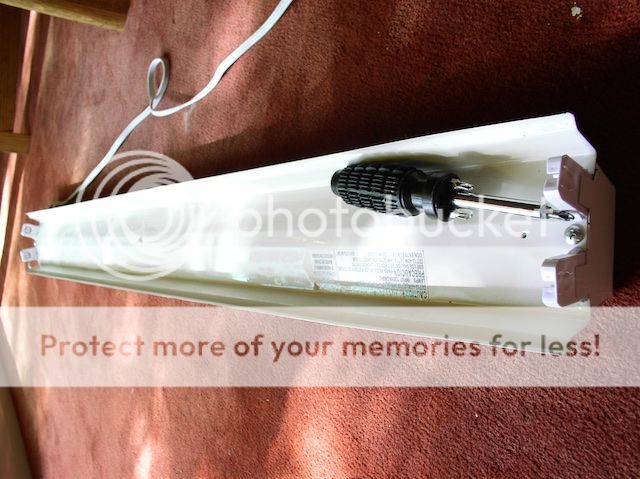
- This is how it look like inside. The box is the ballast, which I need to remove. Left side of the ballast, you can see the "tombstone" (fluorescent lamp holder), the place where bulbs get attached. From the bottom of the fixture, you can see the AC-plug wire coming in. There are 3 wires from this AC-main in. Green is "ground" connected to the pin of the AC plug. Black one is the "Live/Hot", connected to the smaller blade of AC plug. White one is "Neutral", connected to the larger blade of the AC plug.
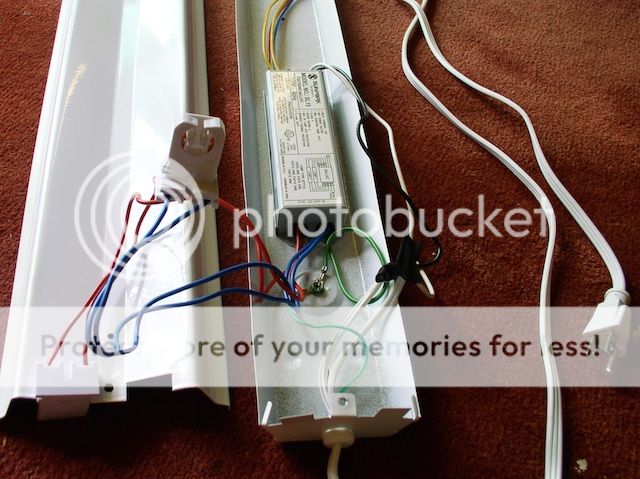
- First cut the Live and Neutral wires from the ballast.
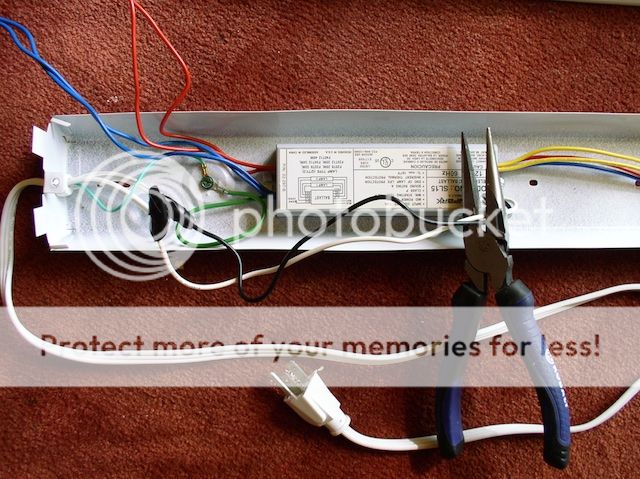
- I'm using an Ohm meter to confirm that the black in Live and white is Neutral.

- When you look at the end of T8LED, one end has "L" and "N" marks. Basically all you have to do is connect the AC power (Live/Hot) to "L" and AC Power (Neutral) to "N". The other end of the bulb has 2 pins, but these are not electrically connected to anywhere. That end is just to retain the bulb to the fixture. This design is "single-ended" because all of the wiring is done in the tombston of one end of the bulb. Sunritek can make "double-ended" (one end of the bulb is connected to AC Neutral and the other end is to AC Live).

- When you look at the tombstone, there are two blade which make the connection to the light bulbs. Below the blade, the two left holes are connected to the left blade, and 2 right holes are connected to the right blade. Currently two blue wires are going into the two outside holes.
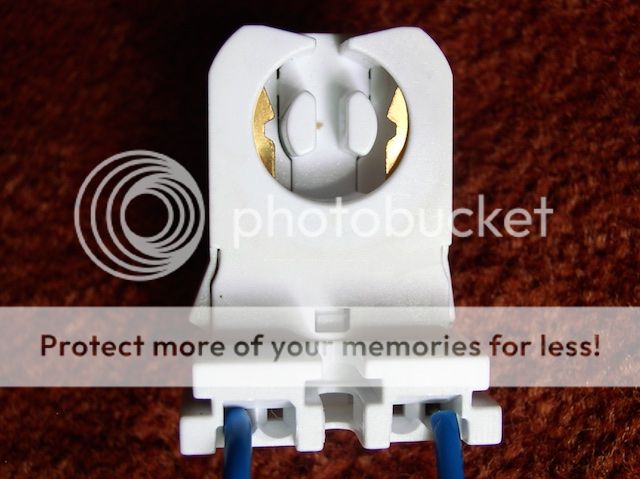
- The trickiest part of the conversion is to remove the wires from the tombstones. I pushed in something like a paperclip (you need to use a pretty thick paperclip), then pulled the wire out. Sometime, I can get the wires out by twisting and pulling the wires gradually without inserting anything.
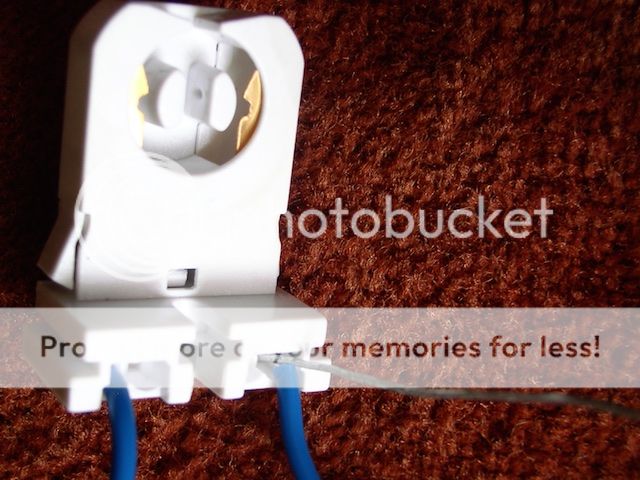
- After the wires are removed, I'm making sure the right and left blades are not internally connected. This is called a non-shunted tombstone. Most of them which I encountered are the correct non-shunted tombstones. But there are some shunted tombstone, where the two blades are bridged/connected. For the single-ended LED T8 bulbs, we need non-shunted, so you need to check it.
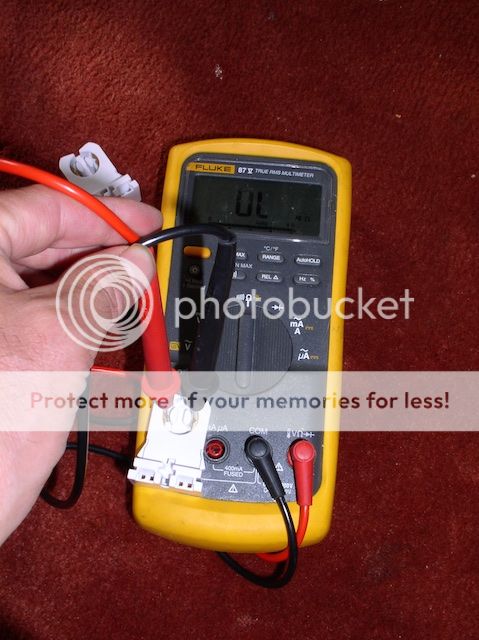
- This is how the finished wiring looks like. The AC neutral (white) is connected to one side of the tombstone, and AC Live (black) is connected to the other side of the same tombstone. Then you use the 2 remaining holes to make the connection to the second tombstone. This is basically a parallel circuit. I already removed the ballast in this photo.
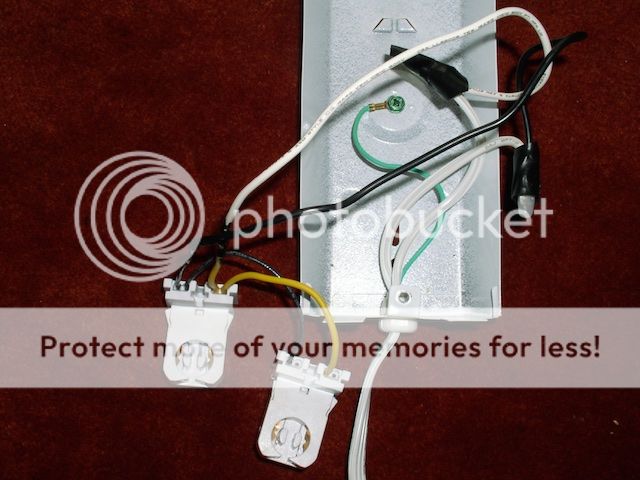
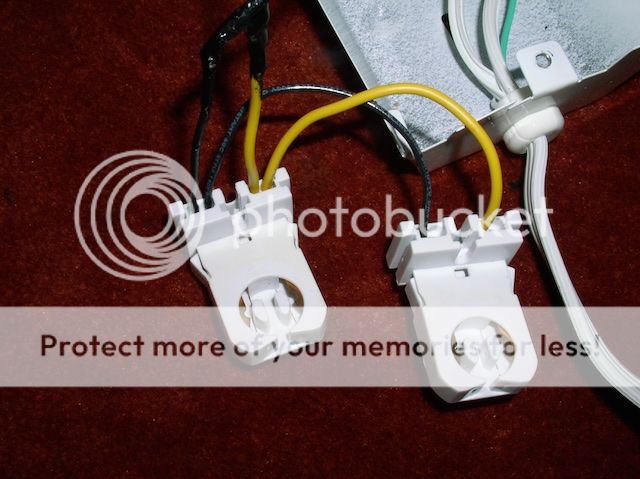
Code:ASCII wiring diagram /----------------\ AC Live ------ L of bulb-1 \--- L of bulb-2 AC neut ------ N of bulb-1 /--- N of bulb-2 \----------------/ - SMD2835
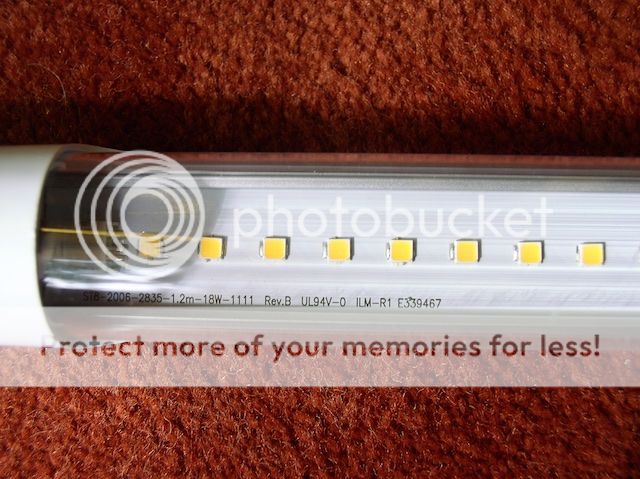
- Backside (label) of the bulb. The end with this sticker is the one which needs to get connected to AC.
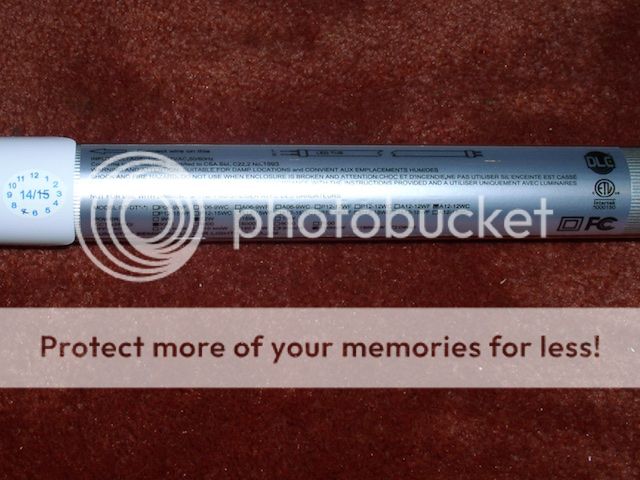
- The one on the Left has the aluminum casing (DTA), the one on the right has the plastic casing (DTP).
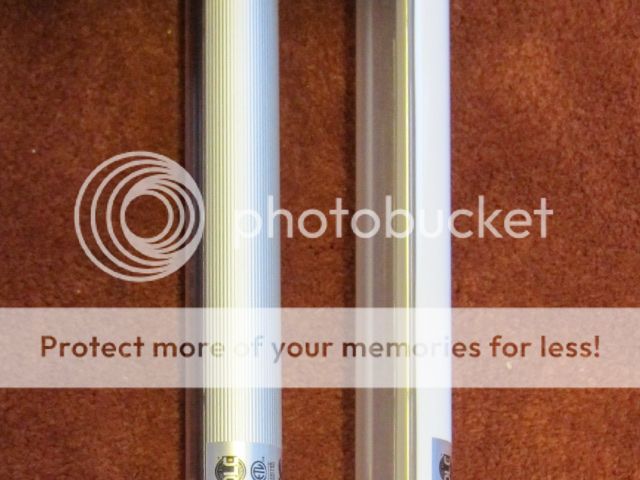
- Comparison of DTA(3000K) (bottom) and DTP(4000K) (top). Note that the DTP has slight frosting.
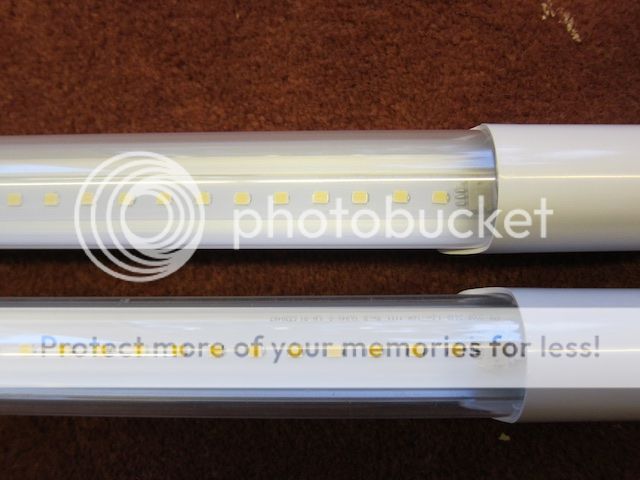
- Because of the slight frosting of DTP-series (right), it looks brighter in this photo, but it is not the case from the measurement (see above).
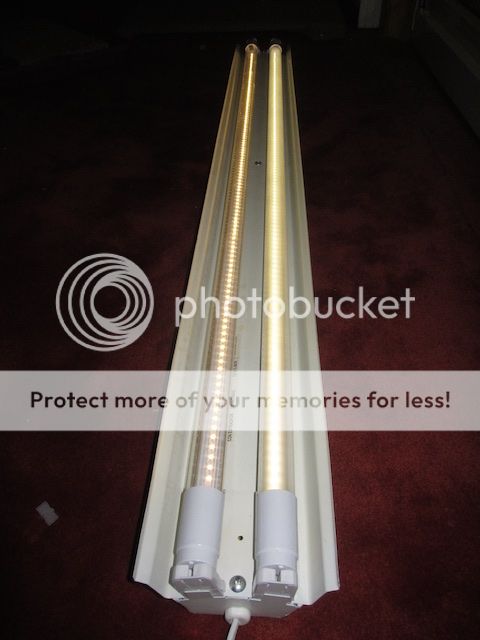
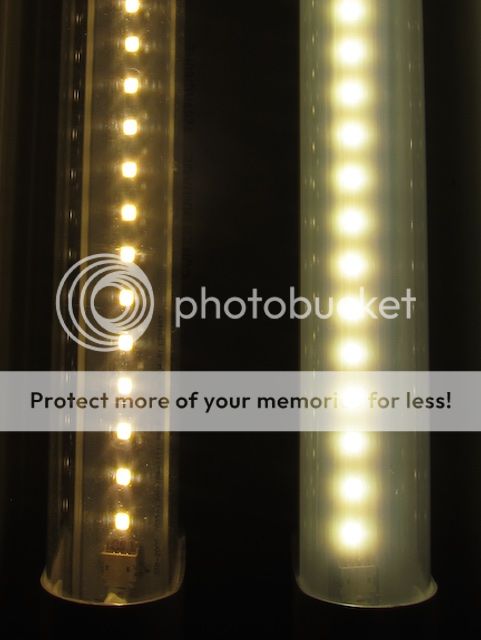
- The clear case part appears to function (creating a wider beam angle). This creates the stripy pattern you can see on the carpet here. But you can't see the pattern if the bulb is not too close to a flat surface and this isn't a problem in reality. DTP shows less pattern due to slight frosting.

- Dr.Meter LX1330B lux/fc meter (left) and Li-Cor Quantum PAR sensor, LI-190 (a link to the newer version of this), and old meter, LI-185 (right, a link to the modern version of this). I think that the values on the meters correspond to 2 bulb per fixture setup. I also use P3 International Kill-a-Watt P4460 to measure the actual energy consumption (which could be different from the specification by the manufacturer).
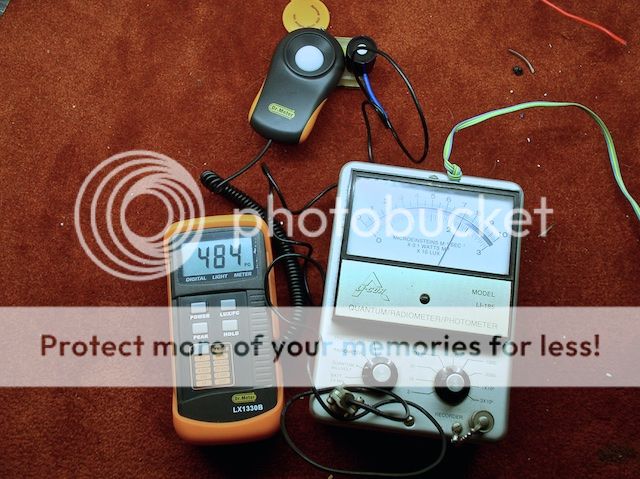
- Here is my quarantine/acclimation grow tent. The plants here are recently imported orchids from Bela Vista of Brazil, Ooi Leng Sun of Malaysia and Malala of Madagascar. The top part is using 4 bulbs of T8-LED and the bottom part has 2 bulbs:

If you are interested in making a simple, cheap fixture from lumber, you might want to check out another post (link here).
I know lumens aren't a good measure when choosing lights, but out of curiosity, what is the per-bulb lumen rating of the Sunritek bulbs you chose?
ReplyDeleteThe one I got is supposed to be 1800 lumen from 12W. They have 15W and 18W versions, too. These have the same number of diodes, but they are driven at a higher current. So it sacrifices the efficiency. I don't have the exact number of the total lumen output for the higher watt version. But 15W is around 140lm/W (2100 lumen). 18W version comes in 3 different efficiencies (higher price for the higher efficiency version), which are probably using different "bins" of the diodes. When I talked to them last year, they said that they can reach to almost 140lm/W (2520 lm) with 18W, which is very impressive.
DeleteLooks very interesting and promising. How are the plants doing after one year and a half? I am thinking also about 4' T5 leds for Cattleyas.
DeleteThanks for the comment, Stefan. Plants are doing well, and I haven't had a single failed bulb yet (I have a fair number of Sunritek bulbs). So I'm pretty happy with their quality. The efficiency of T5HO-LED bulbs are not as high as T8, and there are still limited suppliers. I mentioned a bit of info about T5HO-LED in this thread (starting from msg # 11): https://www.orchidsforum.com/threads/t8-led.19206/#post-131130
DeleteThank you for the reply, which I did not see until now. Probably missed the e-mail, if there was one for the follow-ups.
DeleteAs I was saying, I actually tried since then the T5 Philips LEDs. The lighted area (part with leds, without drivers) is even shorter than that of a regular 4' T5HO so for a 4' shelf it gets a bit dark on the sides, but I must say that I have never seen such a fast reddening of a Bc Saint Andre by using these. They do put out (theoretically and with milky cover, so probably less than) 3900 lm for 26W and I have 4 of them. For 30 € a piece, it gets very expensive. Not to mention they are Instantfit so they use the electronic ballasts and that is wasted energy.
I am following the F Series Samsung thread now, because I would like to copy these tubes, but I'm not sure I can manage to make it cheaper, with the 1120 mm costing about 20 € a piece, to which heat sink, driver and cables are added. There is also the new EB gen 2 that is a bit cheaper but scarce at the moment. What is your opinion regarding these?
I think I hijacked this thread, sorry.
Stefan
I found this post to be very informative. I'm wanting to order 30 -12 watt bulbs for my planned cool growing grow-op in my garage in Saskatoon. I've tried to contact Sunritek to order them as samples but they are not responding. You mentioned in your post you had a contact person at Sunritek. Could you please send me her info.
ReplyDeleteThanks
Don Keith
sales@sunritek.com didn't work? I'm not sure if the person I communicated with is still there, but you can email me (you can connect alaska.edu and ntakebayashi with at sign).
Delete